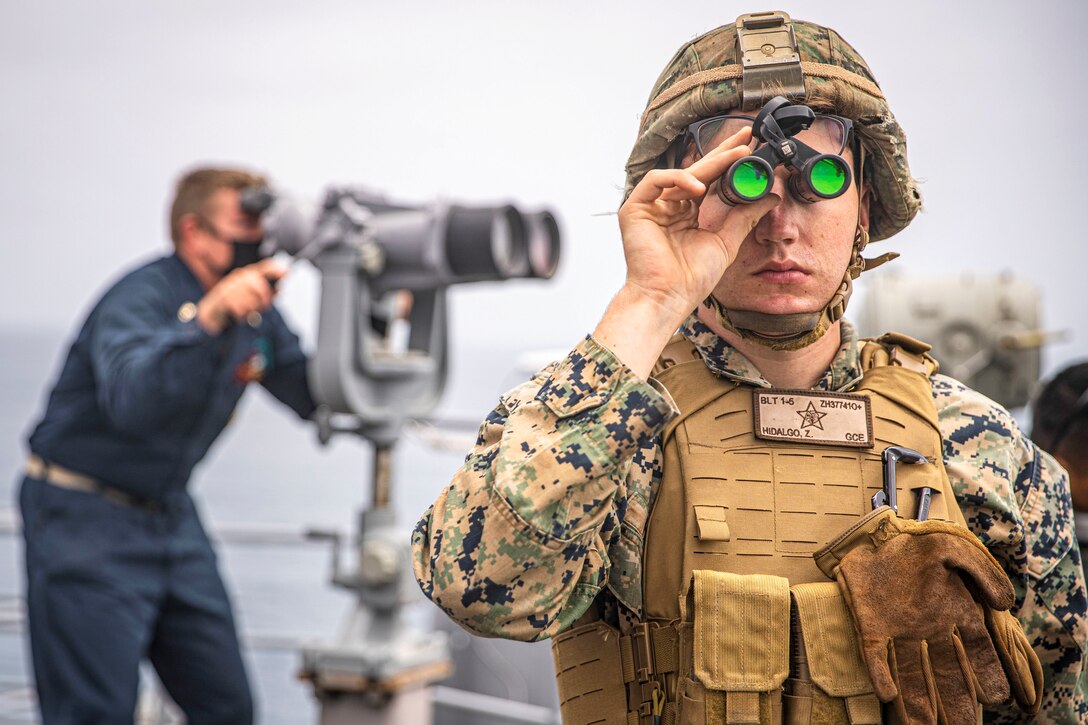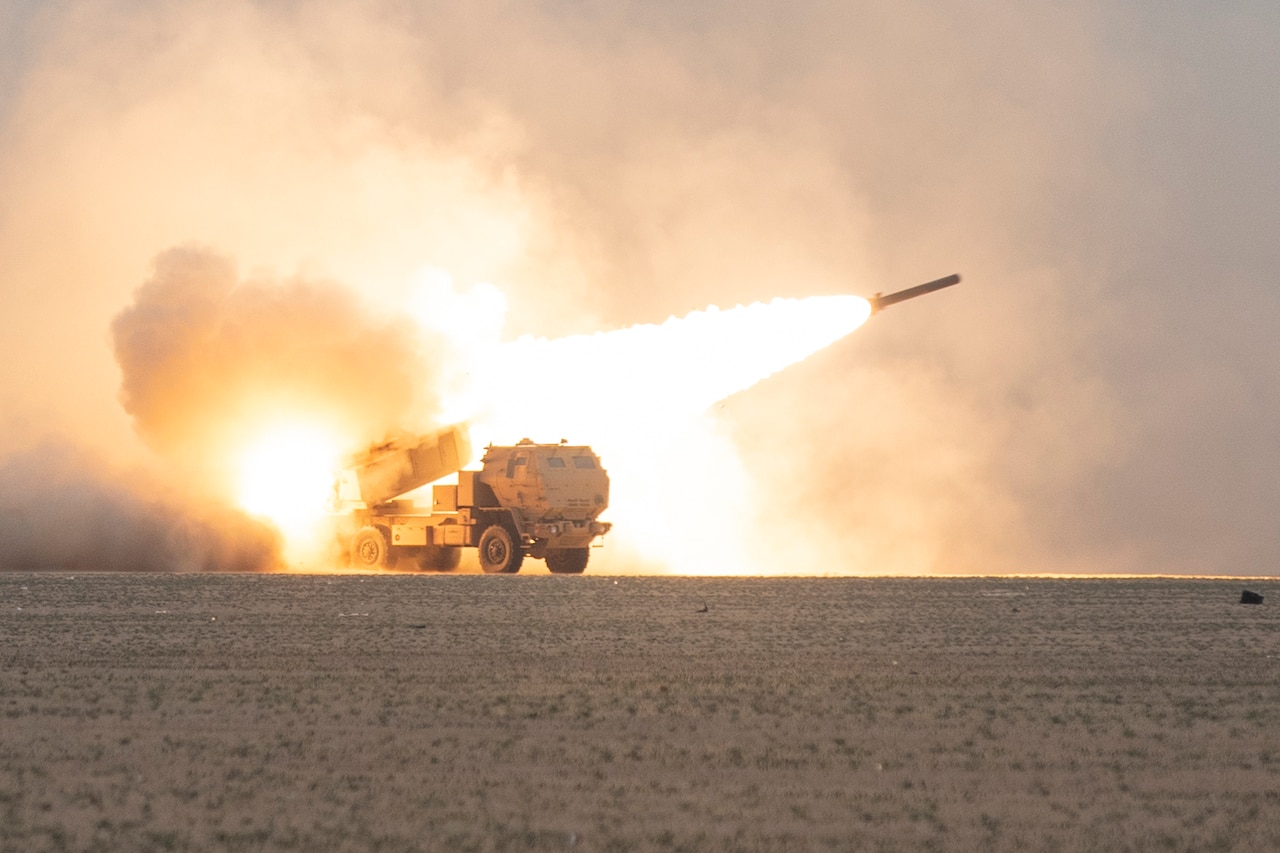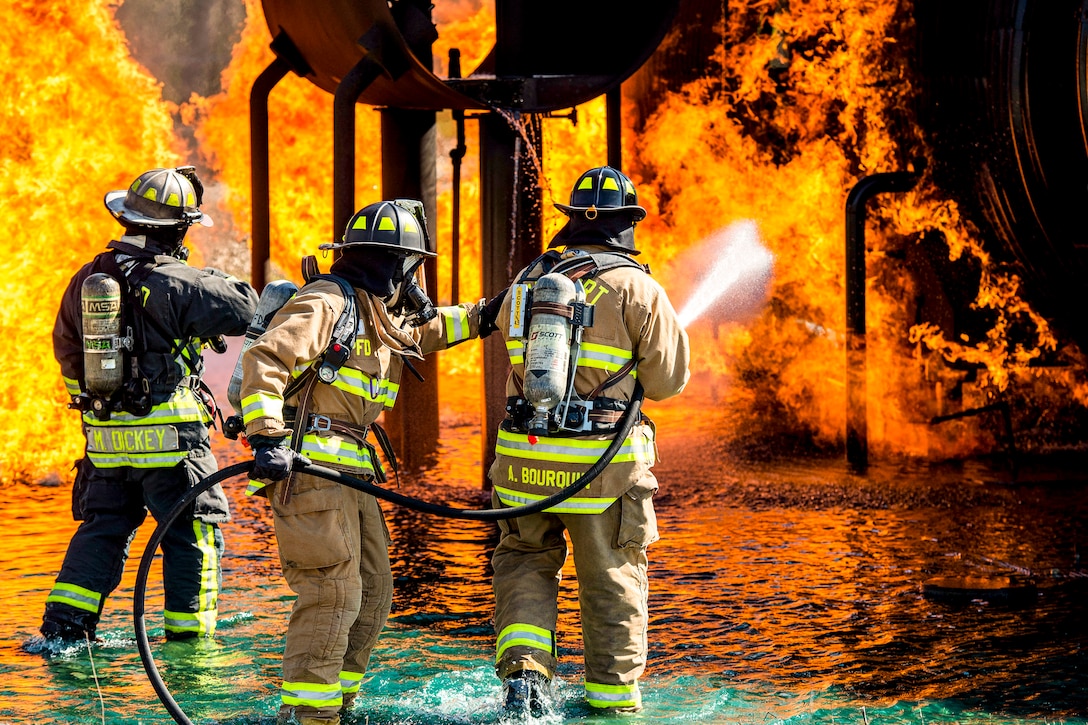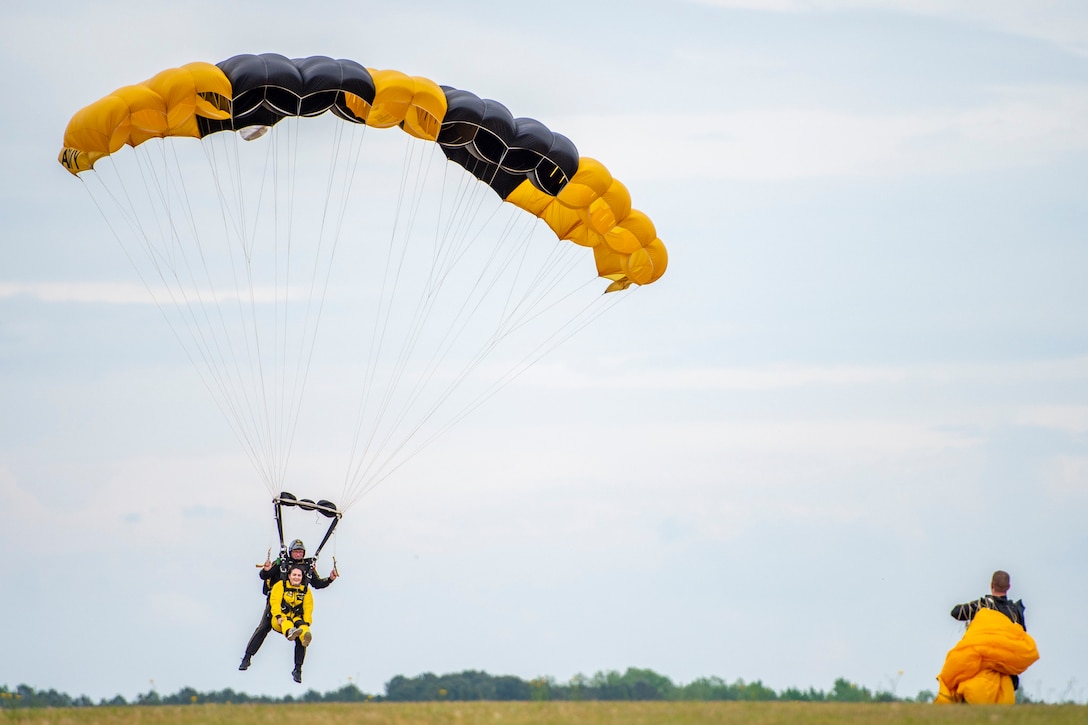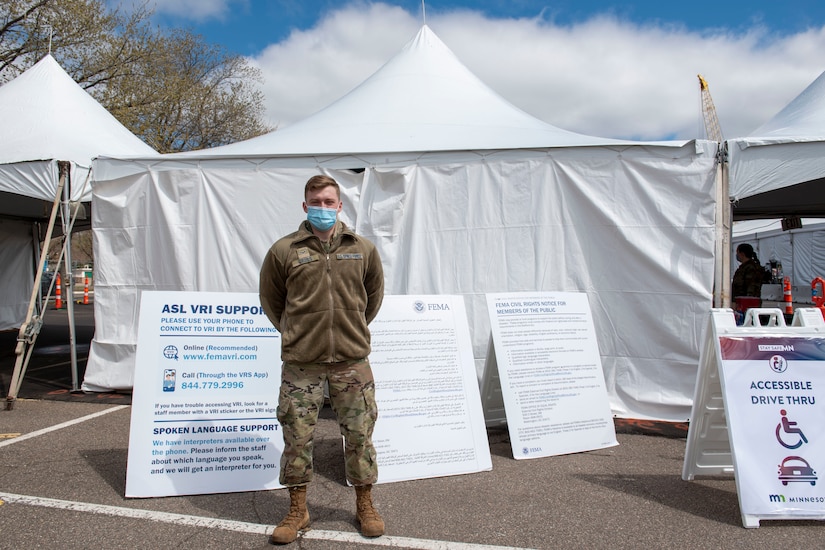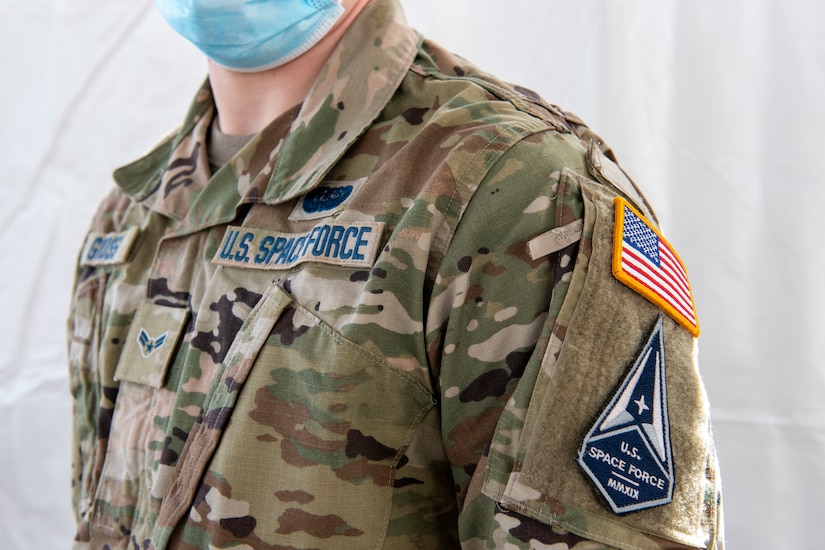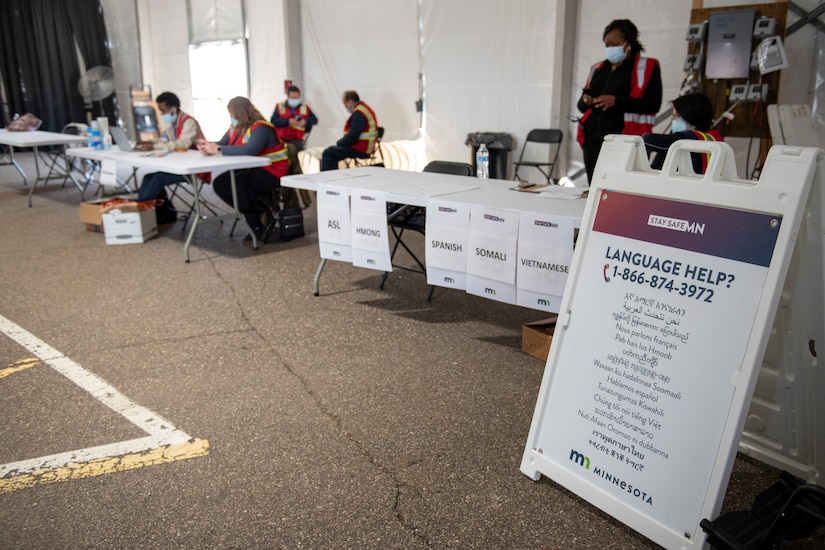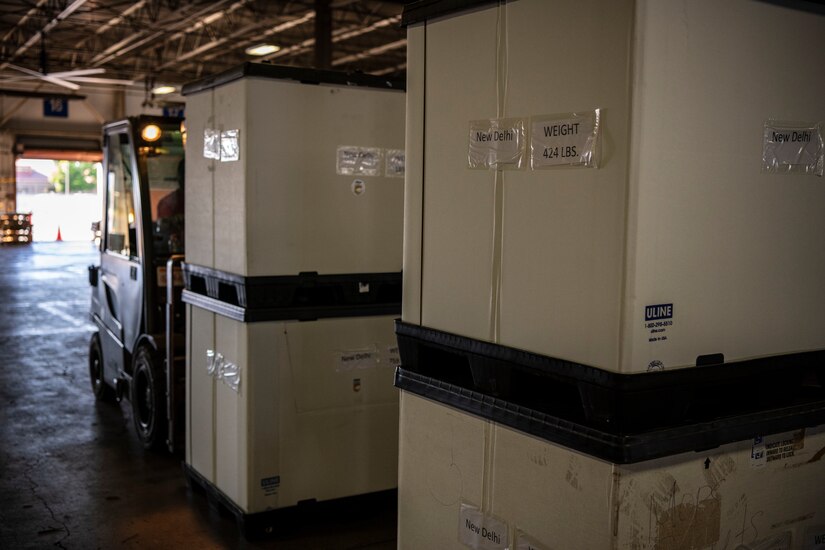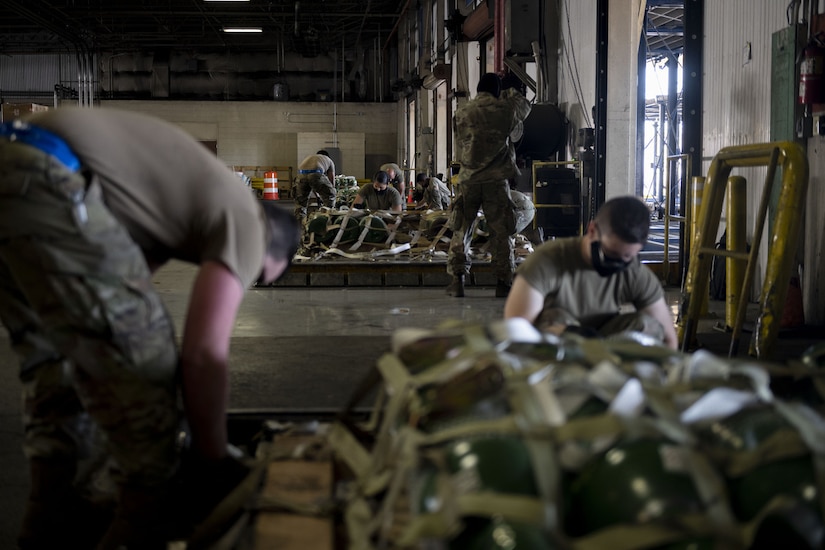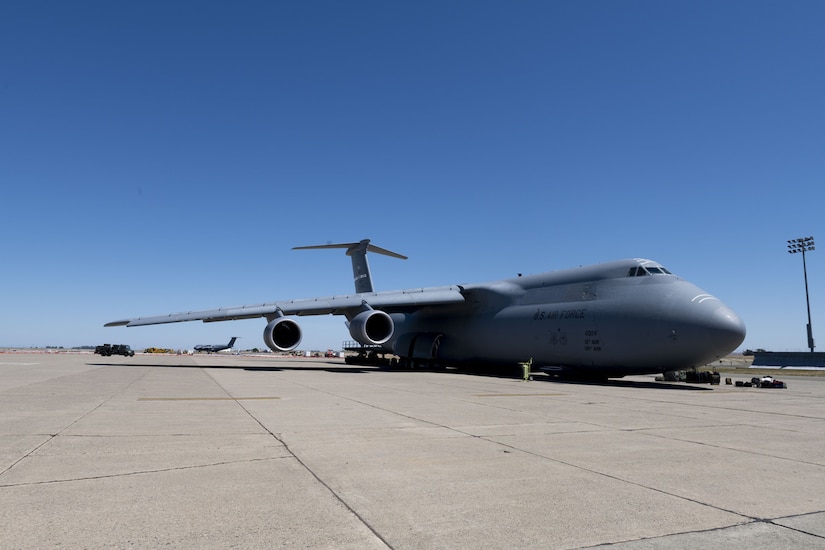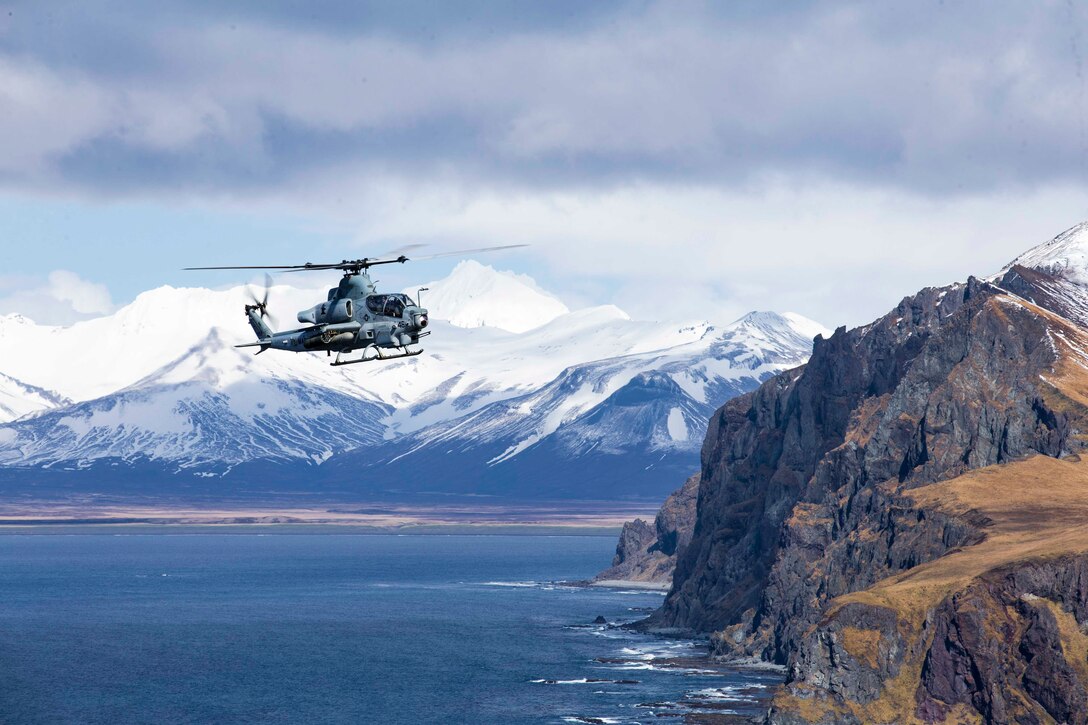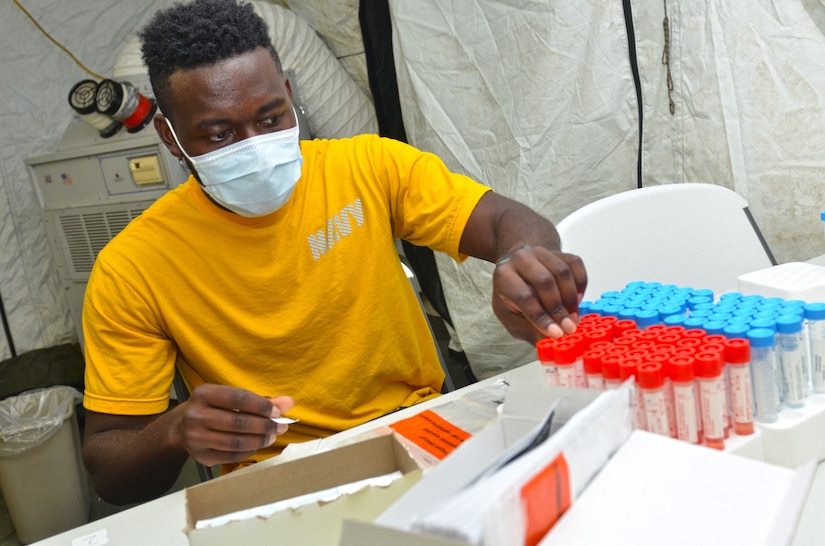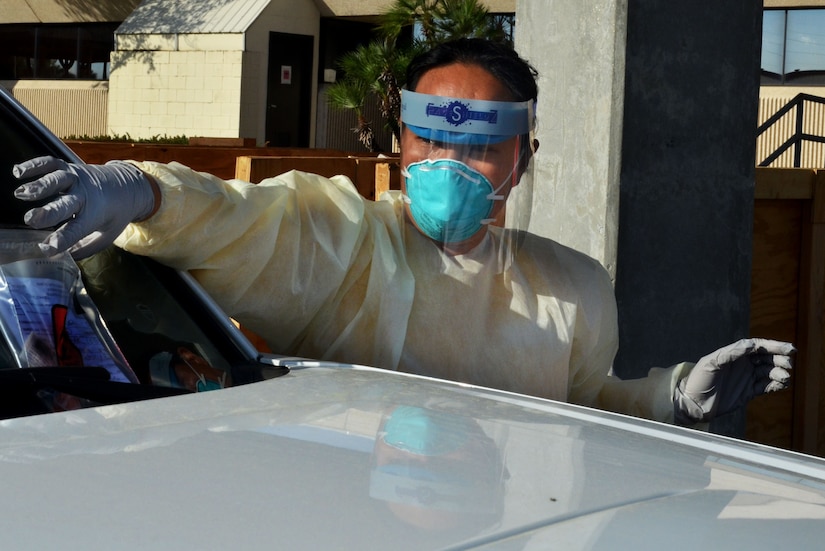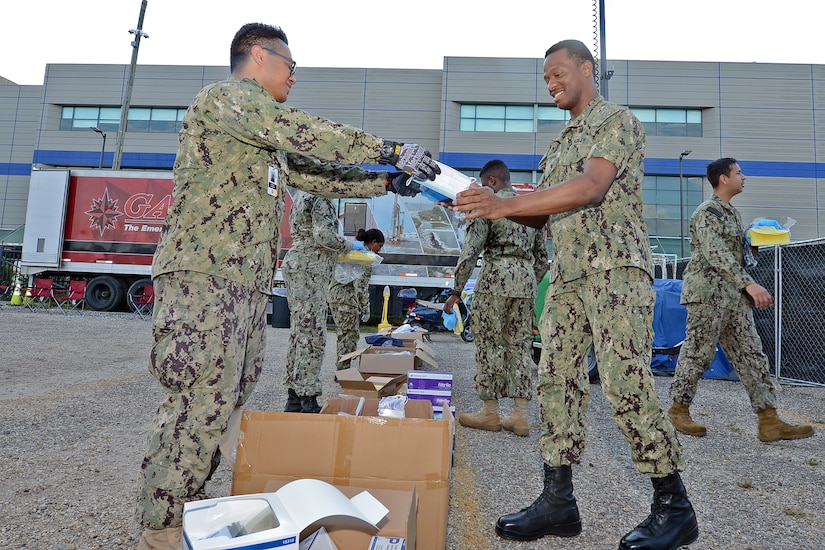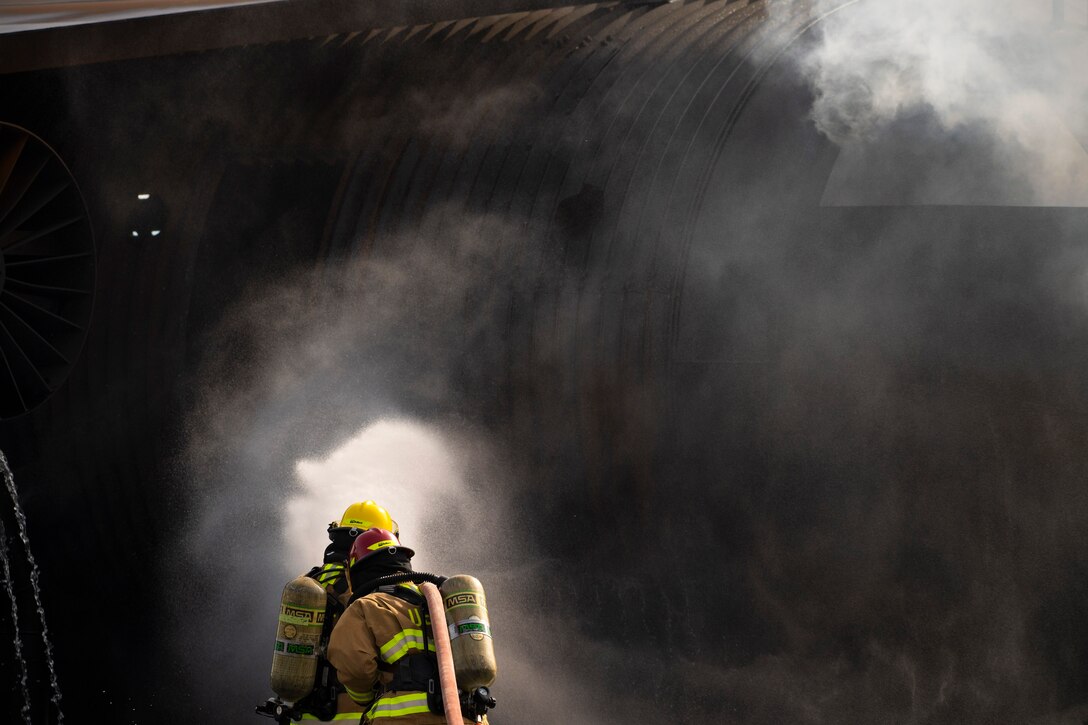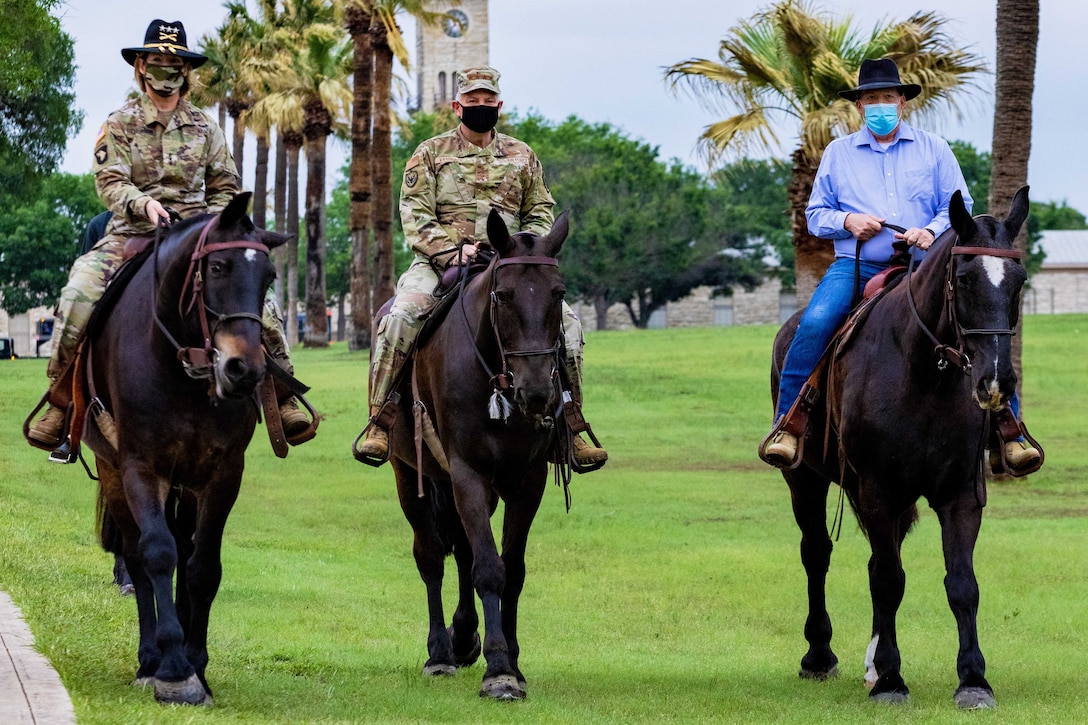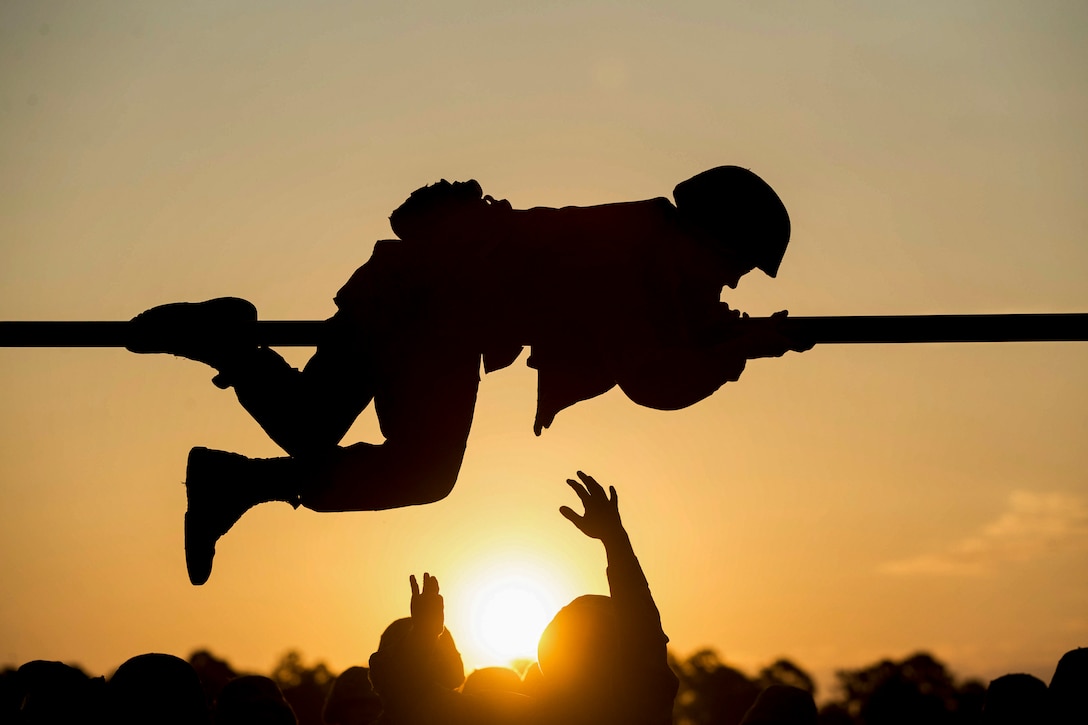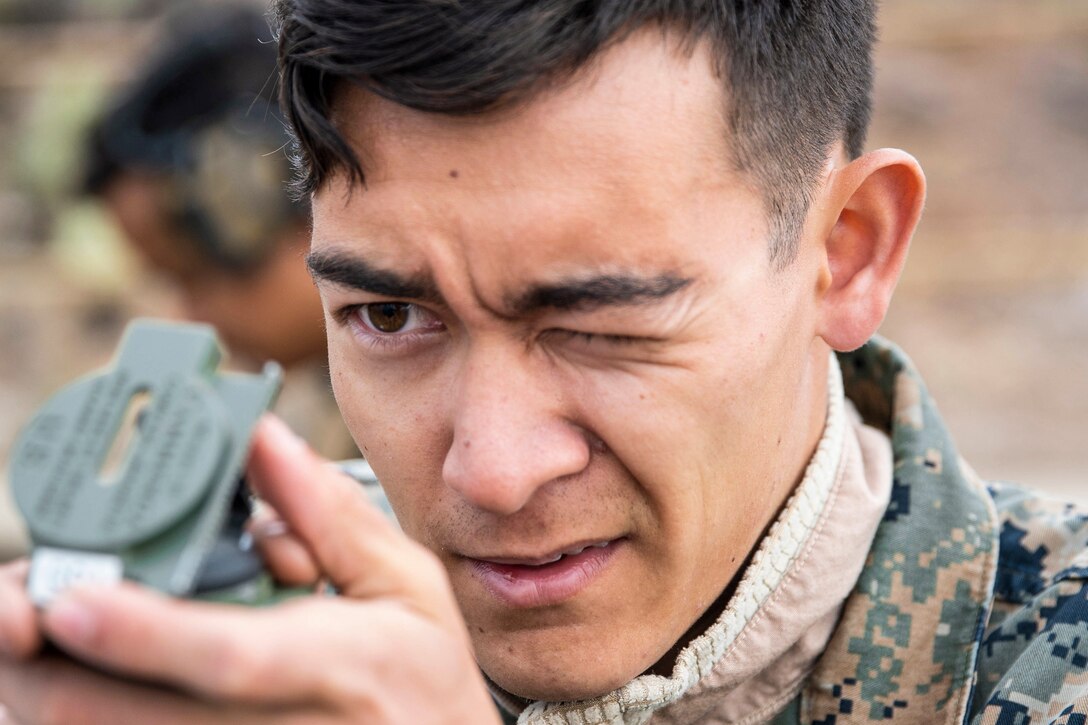May 5, 2021
PRESS SECRETARY JOHN F. KIRBY: All right just a couple of things here to kick off.
As I mentioned on Monday, the Defender – The Defender '21 exercise is going on. They just held yesterday their distinguished visitor day, it was attended by Albanian President and Prime Minister, the U.S. Ambassador to Albania, Yuri Kim, and three four star U.S. generals; General Wolters of course, European Command Commander, U.S. Air Force's Europe and Africa Commander, General Jeffrey Harrigian and U.S. Army Europe and Africa Commanding General, Christopher Cavoli.
If you missed the live stream coverage of the event, that's not problem; it's on EUCOM's website and you can see it that. This was the first time that the joint logistics over the shore capability was exercised and conducted in Europe since World War II. And this is the first time that Albania has hosted the U.S. led multinational exercise as well. And again this is all part of this larger exercise which will run through mid-June with over 28,000 participating personnel from 26 different nations.
So in the next couple of weeks Defender Europe '21 will feature events in Bulgaria, Croatia, Estonia, Greece, Hungary, and Romania. And we'll continue to keep you posted.
Today also the fourth military aircraft landed in India delivering much needed life saving supplies – I should say the fourth U.S. military aircraft. Now on these four flights U.S. Transportation Command delivered 1 million rapid diagnostic tests, 545 oxygen concentrators, more than 1.6 million N95 masks, 457 oxygen cylinders, 440 regulators, 220 pulse oximeters, and one deployable oxygen concentration system. Do not ask me what those things do.
And that is just part of the whole-of-government response to our friends in India. And of course we remain in communication with them to see if there are other ways we can help them defeat COVID as we all move forward.
Today, also on the COVID front, the National Guard is going to be announcing that they've administered over 10 million doses to the American people, 10 million doses. And we in DOD also just hit 3 million doses administered to the DOD population.
Also today, Secretary Austin, I think you may have seen, Secretary Austin directed that the Assistant Secretary of Defense for Special Operations and Low Intensity Conflict. The Assistant Secretary for Special Operations and Low Intensity Conflict retained – the office retains its direct reporting chain to the Secretary for its administrative chain of command role over U.S. Special Operations Command.
The Assistant Secretary remains a principle staff assistant and will continue to have full access to the same floor that service secretaries have. The Secretary also directed that the SOLIC organization, as we call it, now we joined the office of the undersecretary of defense for policy organization. This will ensure that special operation's policy is fully integrated into all the other aspects of the department policy making process.
We'll soon be publishing a revised charter which will further codify SOLIC's – the ASD for SOLIC's role and responsibilities. These efforts are significant steps forward toward strengthen civilian oversight of U.S. Special Operations Command and the provision of integrated policy advise for the Secretary and for the department.
On another scheduling note, the Secretary is scheduled to provide the commencement address for the U.S. Military Academy at West Pointe later this month on May 22 and he's very much looking forward to that.
This week on personnel, we on-boarded Chidi Blyden as Deputy Assistant Secretary of Defense for African Affairs and Michael Donley as Director of Administration and Management, that brings our total of appointees to 110.
And lastly in recognition – in recognition, of what looks like the development of the Pentagon press corps 2.0, I want to take time to congratulate somewhat belatedly in some cases, Carla Babb, Courtney Kube, and Nick Schifrin on the births of their new children. I wish them all the best for sleep. I'm a grandfather now so I don't have to worry about that but I remember those days and I wish them all and their families well as all of us do here. It's great to see.
OK. We'll start with Bob.
Q: Thank you. John, I have a question for you. This morning General Milley was speaking at Howard University and talking about other things about racial issues in the military. And he was expressing concern about the lack of advancement opportunity in the military for black Americans. I'm wondering whether Secretary Austin sees this as something that can be addressed in the short term?
And also does Secretary Austin think that something can be done to improve what is currently a total of only two blacks among 41 – among the 41 four star generals and admirals in the military that only two are black? Is it something that Secretary Austin thinks can be – can be improved?
MR. KIRBY: The short answer to your question, Bob, is yes. And he agrees with Chairman Milley that there's much more that we need to do to improve diversity and inclusion and opportunity inside the force. And it's something that he has tackled literally since becoming Secretary of Defense.
We've hired, as I think you know, Bishop Garrison to be our director for diversity and inclusion and equity, and he's given Bishop a wide berth to take a look at these kinds of issues across the force, to see how we can improve our diversity better.
He is, to your second question – and he has talked about this. He's certainly concerned about the diversity at the senior levels of the department. This is not just senior enlisted levels, but senior officer levels, admirals and generals. As you rightly pointed out, Bob, the numbers are not – they're not very high.
So the secretary believes this has got to be a concerted effort, an every-day effort. It's got to be led. If leaders across the department don't take this on as a personal commitment, it's not going to change.
To your first point, he knows it's not going to change overnight. That doesn't mean you slack up on the pressure, you don't – you don't continue to try to get this right. But he understands that this is going to – it's going to take time to grow that kind of leadership and that kind of talent, but he also believes there's a sense of urgency, or the time is now, to start to grow that talent and develop that talent and provide opportunities for that talent to continue to advance up the ranks.
The last thing I'll say on this – and I can't say it any better than he has – is that this is a real – this is a readiness issue. It is important for the force to look like the country it serves, absolutely. But he strongly believes that diversity is a readiness issue because it allows different perspectives, additional context, different lived experiences to inform the way we make decisions and the policies that we craft, the operations that we lead. So it's very much a part of making us a much more capable force.
Q: Thank you.
MR. KIRBY: Tara?
Q: Is the secretary tracking the fall of the Chinese rocket? And if it looks like the rocket will fall on U.S. mainland or territory or one of our allies, are there any options being considered to possibly shoot at it, to maybe disintegrate it into smaller pieces?
MR. KIRBY: The secretary is aware, and he knows that Space Command is tracking – literally tracking – this rocket debris. It's almost the body of the rocket, as I understand it, almost intact, coming down, and we think Space Command believes, somewhere around the 8th of May.
It's too soon to know exactly where it's going to come down. And – but again, we're tracking that. He is aware that Space Command is tracking that, he's getting updates on it.
I know of – I think it's also too soon to explore options about what if anything could be done about this, until we have a better sense of where it's coming down. So I don't want to hypothesize or speculate about – about possible actions the department might or might not take here. We're tracking it, we're following it as closely as we can. It's just a little too soon right now to know where it's going to go or what if anything can be done about that.
Q: Just a quick follow-up, do we know when you'd have an idea of where it would fall? I mean, because, at some point, like, if it's hours before, isn't that too late to form a plan to potentially do an intercept or anything that might help protect any sort of land population that could be hit?
MR. KIRBY: I’d have to refer you to Space Command for that. I don't have – I'm not proficient enough in how the fidelity of information and the speed with which analysis is coming in on this, so we'd have to refer you to Space Command for like more detail about how they will – when they will be able to narrow the cone of possible re-entry and (INAUDIBLE).
Barbara?
Q: On the same subject, two questions. What are your procedures and plans for notifying states and also foreign countries if you begin to calculate it could hit land rather than the ocean? And after that I have a follow-up.
MR. KIRBY: Again, I think we just don't – we don't know enough right now to be able to – to formulate specific notification plans. I mean, but obviously, if – if we have information that can be of use, we're going to share that appropriately, the State Department, through their channels and certainly we would – we would provide as much information to that process as possible. But I just don't think we're there right now, Barbara.
Q: Well, I want to follow up on this question because in fact, Space Command has now publicly said they may only know a few hours ahead of time, where the point of re-entry will be, and that's the first step to knowing where it's going to hit. So if you only have a few hours of knowing ahead of time where re-entry is, has the secretary – it seems difficult to wait for that to come up with a plan.
I think the question is, has the secretary even asked for any – or the chairman, or anybody – asked for any briefings, options, ideas? When he's briefed up on this ,what are they telling him? Because a few hours' notice on Saturday may be – may go very quickly, so what's happening right now?
MR. KIRBY: I think – I think we need to talk about where we are right now on the – yeah, the third of May. And where we are right now is that Space Command is tracking this, we don't have enough fidelity of information right now about re-entry and what – what that's going to look like to speak to specific actions one way or the other.
This is something that the secretary is clearly aware of, he is – he's keeping up to date on it. And when we know more and when we can share more, we certainly will. But we're just – you know, we're just too far out right now to begin to speculate about what possibly could be in the offing here.
Let me go to the phone, Idrees. You there, Idrees?
Q: Hey, John, can you hear me?
MR. KIRBY: I can.
Q: Oh, OK. Two questions. First is on Afghanistan. Obviously – you've obviously seen the news about the Taliban offensive in Helmand. Have U.S. forces assisted the Afghan forces with airstrikes or anything in that offensive? And then I have a totally unrelated question.
MR. KIRBY: Yeah, I'm – I'm going to demure on speaking on specific operational support to the Afghan forces and any – in any particular operation. As I said the other day – and General Miller has made clear, to the degree we can, as we transition out, we're going to continue to try to support Afghan National Security Forces in the field but I'm going to refrain from speaking to specific – what that support looks like specifically, and refer you to – to either Central Command or U.S. Forces Afghanistan.
Q: Sure.
MR. KIRBY: You had a second one?
Q: Yeah, second one. So I think earlier this week, you tweeted out that Secretary Austin would be attending the Shangri-La Dialogue in person. So since then, obviously, you've seen what's happened with the Indian delegation and G7 in London, and Singapore has increased its quarantine period to sort of counter COVID measures.
So I was just curious if you could sort of explain the thinking of the Secretary about why he needs to be in person, given the increasing risk in the region, and what makes him so certain that it will be safer, him and the delegation – broader delegation given the delegations from other countries that may not necessarily all be vaccinated?
MR. KIRBY: It's a fair question, I think – so a couple of things. First of all, obviously we take all necessary precautions here among the staff on a daily basis, but certainly as he travels. And so we're following CDC guidelines – the staff around him is fully vaccinated. He, of course, is fully vaccinated. And while we're on the road, as we have traveled, we observe a strict – again, strict CDC guidelines.
We're very, very careful. So that will not change for this or any other trip that he's got coming up domestically or internationally. The organizers of Shangri-La have, as I think you probably have – it sounds like you've seen, they've taken many stringent precautions as well, and are putting in place very stringent protocols for the events as well.
We've taken a look at – at those protocols and those requirements, and we're comfortable that they too will help contribute to a safe environment. So the secretary – this is an important dialogue, Shangri-La. It's an important convening event to, again, revitalize our alliances and our partnerships in that part of the world to – to make clear how much we are prioritizing the Indo-Pacific theater in the region.
And, again, the secretary, he's privileged and proud to be able to attend. We're looking forward to it. And obviously as – you know, between now and then, we'll continue to monitor the COVID situation around the world, but right now, we are content that the proper precautions and protocols are in place to make this a safe evolution for the secretary to attend, otherwise we – we certainly wouldn't do that.
Yes, Pierre.
Q: There are now six B-52s in the area of CENTCOM?
MR. KIRBY: Yes.
Q: It will be a drawdown and withdraw of the forces from I understand needs this amount, why does it need it anyways?
MR. KIRBY: We've talked about this, Pierre, – and – actually we've talked about it several times. The Secretary is committed to a safe and orderly, responsible drawdown. And we have made it exceedingly clear that protecting our forces and the forces of our allies and partners as they too withdraw is a priority, is a main priority. I mean, part – you know, the first word out of our mouths is safe, right, a safe withdrawal.
And the – the secretary has approved some additional assets in the region to help us ensure that protection, and the B-52 bombers are part of – that force. We've also extended the USS Eisenhower into the region, extended their stay there in Central command area of responsibility, and we have made plans to introduce additional ground force capabilities to, again, make sure that this is safe and orderly.
The secretary believes that – that these decisions are the right decisions, and that they allow General Miller the options he needs to continue to make sure that this drawdown goes safely.
Q: A different topic if you don't mind. We've seen the harassment by the IRGC speedboats at sea. We've seen also some attacks on Iraqi bases where we have contractors. And yesterday, I believe we had an attack on a base that housed U.S. troops. Is it the level of risk or threat that we have to live with? Are you ready to live with that?
MR. KIRBY: Ready to live with?
Q: With this amount of a threat that is coming on – on the troops in Iraq?
MR. KIRBY: Well, again, we said we're – our force protection of our forces are priority number one. If and when we believe some sort of response is necessary, we'll do that in a time and place of our choosing. Nobody wants to see these sorts of attacks occur, and we're monitoring it very, very closely. So if your question is do we – will we want to operate forces where these sorts of attacks are occurring, of course not. We don't want to see these attacks occur.
But we also are committed, you talked about Iraq, we're committed to the mission in Iraq, which is there, again, at the invitation of the Iraqi government to help them prosecute the war on ISIS, which we still believe is a valid mission.
And - that's important too. I think we all – you asked, you know, do you want to live with these attacks, I would ask – turn the question around, do you want to live with an ISIS that can reconstitute itself and could – and – and to pose a bigger threat to the region as they did back in 2014?
And I think we would all agree the answer to that is no. And one of the ways you help prevent that is by improving the capability and the competence of the Iraqi security forces.
Let me go back to the phones here. Jeff Selden?
Q: Can you hear me now?
MR. KIRBY: I got you, kind of faint.
Q: Okay. Thanks very much for doing this, I'll speak up. Just wondering, as of right now, without looking ahead to the coming weeks, but as of right now, is there anything materially different about the type of support that U.S. is able to offer Afghan security forces as opposed to what it was able offer of just a few days ago, before May 1, in terms of air support or advice or intelligence?
MR. KIRBY: Again – so I'm not going to get into specific operational details and the kinds of – the specific tactical support that is being provided to the Afghan forces, but I also would point you to Central Command’s statement, I think yesterday.
They're going to start putting out sort of a weekly update, and I think in their estimation, we were between 2 and 6 percent along the drawdown accomplished, so it's in its early stages, which I think, you know, you can take away from that, that there's still quite a bit of robust capability at General Miller's discretion to continue to support Afghan forces in the manner he sees fit. And I think that's about as far as I can go on that. Meghann?
Q: Do you have updated numbers on the number of active duty troops who are manning FEMA vaccination sites and the number of teams?
MR. KIRBY: Wow, Meghann. (INAUDIBLE) You haven’t asked me that in a long time.
Q: Well, I'm wondering if FEMA is still – making requests or if you
guys are turning more towards starting to bring some of those – not
necessarily shut the sites down, but bring some of those active duty
troops back to their bases?
MR. KIRBY: You know, Meghann, I don't know if I've got that here, wait a minute, I might, hold on. (INAUDIBLE)
So, as of today, the total deployed personnel in support of FEMA is 4,766, total vaccination teams deployed, 34. So, that's actually a few more than just a couple of weeks ago. We're still at it.
Q: So requests are still coming in for more teams, is that fair to say?
MR. KIRBY: I think that's safe to say. Now, what that looks like going forward I don't know, but just a few weeks ago when you asked this question we were at 31 and now we're at 34. So it's still – it's still a very active mission and we're still very much in communication with FEMA about their needs. Yes.
UNKNOWN: (INAUDIBLE)
MR. KIRBY: Well, I found that one, that was good. I didn't know...
UNKNOWN: (INAUDIBLE)
MR. KIRBY: Yes, no, I – I wasn't sure where. Steve – Steve Losey.
Q: Hi. My question has to do with the comments Eddie Gallagher made on a podcast that came out yesterday –– in which he says that his platoon intended to kill the ISIS prisoner and agreed to conduct medical – practice medical procedures on him until he died. Does the Pentagon have any comments on – Eddie Gallagher's comments on – on this podcast?
MR. KIRBY: I'd – I'm not sure, Steven, that I'm going to dignify those comments with a response.
MR. KIRBY: Sylvie?
Q: Can you – can you, I’d like to go back to Afghanistan and the bombings today. Are we to understand that the –– as soon as you withdraw from one province or one region, the Taliban are going to gain ground and you will – we will have to fight every time with the Afghans to try to push them back?
MR. KIRBY: The Afghan Security Forces are more capable than they have been in recent years. And they are – and I think this is important to remember, they have been in the lead for quite some time, of operations.
And yes, they have received some U.S. and coalition support, no questions. But they have for a long time now been in the lead of operations in their country. And they are fighting today. To the degree that we can as we draw down we'll continue that support, but eventually that type of direct support won't be available to us or to them.
But as I said, we're going to transition to a different relationship with Afghan forces in a different – executed in a different way. This is also – I think we need to remember, this is their country to fight for. This is their land, this is their people. And as General Miller said himself, they have to be ready for that mission.
Q: Journalists on the ground quote some local government officials that say this bombing was very intense. I've never seen such intense bombardment in several years. So does it mean that this safe and orderly withdraw is actually going to be bloody and very difficult?
MR. KIRBY: Well we obviously don't want it to be either bloody or very difficult. We are only in the early stages of it and so far General Miller has been able to execute to plan. That doesn't mean there hasn't been, as I talked about the other day, some harassing attacks. But it – they haven't been of a nature that have impacted his ability to execute the withdrawal, which is the new mission set he now has.
And General Miller knows the country well, he also knows the capabilities that he has at his disposal and he – at his disposal and he knows the Afghan forces very well. So, he will continue to be able to provide – continue to provide the support that he can as he also executes this drawdown.
But I want to go back to my answer to Pierre, which the mission of the drawdown is clear, safe, orderly and responsible and that means protecting our forces as they come out. And that is – that is a main priority for General Miller.
Another reason why Secretary Austin approved additional assets into the region to assist him in that effort. And we talked about this a long time ago that you're going to see and you have seen a plus up in the region temporarily as we begin to pull people out.
OK. Jen?
Q : (INAUDIBLE) Does Secretary Austin think that part of that safe orderly withdraw includes evacuating the Special Immigrant Visa combat translators, there are about 17,000 of them? Is that – have any decisions been made on that and does he believe that is a priority as part of this withdrawal?
MR. KIRBY: I don't – I don't – I can't speak to decisions made about the Special Immigrant Visa Program, that's really a question that I'd refer you to my State Department colleagues to speak to.
I talked about this other day though and the secretary shares the President's sense of commitment and obligation to those Afghan's who have helped us for so long on the ground there.
And he is very supportive of the President's desire and the State Department's efforts to expand and to accelerate the Special Immigrant Visa Program so that we can – we can do right by these individuals. But that's really more in the State Department lane.
Q: This military has not been asked to evacuate any of these translators?
MR. KIRBY: I know of no such requests at this time for that. Yes.
Lara Seligman, Politico?
Q: Hi John. I wanted to see if could get an update from you on the sexual assault recommendation. Where does that stand now? Has Secretary Austin talked to the service chiefs yet on this? And obviously General Milley has taken a public stance now. Has he relayed that directly to the secretary? Is that his advice? And does this reflect the opinion of the service chiefs?
MR. KIRBY: I don't have an update for you on the decision making process, Lara. The – as we talked about, the secretary was grateful to receive the recommendations. He wanted to give the services till roughly the end of the month to be able to come back to him with the – with their candid assessment and their feedback. And he wants to respect that process and he wants to give them that time to do that.
He obviously is aware of Chairman Milley's comments publicly about his willingness to be open minded about this. The secretary likewise. You've heard him say that he wants to be open minded about these recommendations as they come forward.
And I know we're specifically talking about the one is – that regards prosecution of sexual assault cases outside the chain of command. I know that's what the question is specifically about. The secretary wants to keep to an open mind about that. He wants to hear from the services and get their views and that just hasn't happened yet.
Abraham?
Q: Thank you, John. Two questions. As the United States moves towards over the horizon activity for Afghanistan after the withdraw, I wondered if you could speak to the level of coordination and integration between the United States Air Force and the Afghan Air Force? And then I have a second question for you.
MR. KIRBY: So we are still working our way through what over the horizon counterterrorism capabilities are going to look like, so it's premature for me to speak with specificity about integration or shared efforts between American – or U.S. air assets and those of the Afghan Air Force.
The Afghan Air Force has dramatically increased in their combat capability and competence. And as we talked about we're going to continue to look for ways to support those air forces, again from outside the country, but it's too soon to get into specific integration tactics or operations at this point.
Q: And the second question, of course you're aware that a fourth service member was arrested, National Guard related to the Capitol riots. I wondered if Secretary Austin is aware of that, what was his response to that?
MR. KIRBY: He's aware of the incident, I don't know that he had a particular response to that single arrest.
Q: So he didn't make a comment to you, or he's not willing – he doesn't have any perspective?
MR. KIRBY: He's aware of the arrest, it's a law enforcement matter – he wants to respect that process.
Let me go back to the phones, I got to keep remembering to do this – Peter Loewi from Asahi?
Q: Hi, John, thanks very much. Two questions on extremism. On calling climate change a threat to national security are you also looking at climate change denialism as a threat to national security? And if so, is denialism being looked at as an indicator for extremism?
Second, last Friday when asked about extremism, Deputy Secretary Hicks said not surprising that is reflective of society, but disturbing in then a higher percentage than society? She later said we know that the vast majority of people who come in everyday are mission focused about supporting America, that's a lot clearer than the 99.9 percent colloquialism used by the secretary. Does the deputy secretary know the percentage, and what is it? Thanks.
MR. KIRBY: Look, in denialism obviously we do believe climate change is a national security issue. I mean, you can see that through the effect that extreme weather has even just on our bases and installations, but not only us but populations around the world which cause draught, and famine, and produce conditions for and climate for insecurity that leads to the governance issues and sadly to conflict.
So it is a national security crisis not only as we respond to the effects of extreme weather, our military forces respond to extreme weather driven by climate change, that also – those are operations and missions that require readiness and resources that can't be applied elsewhere.
So it very much is a national security issue and you heard the secretary talk about that. I'm not aware that denialism itself is considered an extremist ideology, and in terms of the kinds of things we're looking at here at the department.
As I've said before it's more about the conduct and behavior that extremist ideology inspires people to take . Behavior that is prejudicial to good order and discipline in the ranks, and can lead to the harm – physical harm of our teammates.
That's why the presence of extremists in the ranks is a problem for us, because it does erode – as the secretary has said, it erodes at the very fabric of who we are. And it affects our ability, our readiness to execute missions on behalf of the country. And I did not hear clearly what your – how you quoted the deputy secretary, can you repeat that?
Q: Yes, absolutely. So this is not a – this is not a (INAUDIBLE) quote. I didn't get to write it all out. She said – the thing she said specifically is that it's not surprising that the military's a reflection of society, but she said it is disturbing that it is a higher percentage than in society.
And then she later said we know the vast majority of people, and saying we know and referencing a higher percentage implies that that percentage is known, and that the percentage is also – and saying we know is not a colloquialism like the 99.9 percent is, so it really seems to imply that the deputy secretary knows the percentage.
MR. KIRBY : I think you're looking for daylight where there isn't any. The deputy completely agrees with the secretary that the vast, vast majority of men and women in the Department of Defense, military and civilian alike serve with dignity and character.
And she also concurs with the Secretary that though the numbers – we don't have an exact idea of how many people that espouse extremist ideology might be serving in the ranks, we don't have any indication that it's a large number.
It doesn't matter what the whole number is, as the Secretary has said even a small number can have an outsized affect on morale, good order and discipline, and quite frankly, the health and safety of our teammates. And that's what we're trying to get after here.
We obviously would like to have a better idea of the scope and scale of the problem, but let's not get wrapped around the axle on that particular issue – that particular number, whatever it is, because it likely fluctuates. I mean, when we talk about extremism I think it's too easy to get wrapped up into membership cards, or groups with certain odes of their own.
Many people can be radicalized on their own, and then just as suddenly deradicalize themselves. I mean, it's not an issue of what a whole number is on a given day, it's about the affect that it can have on the force – and that's what we're trying to better understand. So I don't think that the deputy secretary and the secretary are – there's even one iota, a scrap of difference between the way they both are looking at this.
Here in the room, yes sir, go ahead.
Q: Thank you, sir. Last week Nigerian President Buhari, he had a virtual meeting with U.S. Secretary of State Antony Blinken, and one of the comments the Nigerian president made, he urged the U.S. Department of Defense to reconsider relocating U.S. Africa Command from Stuttgart to somewhere in the African continent to better able to assist with the security challenges in Nigeria and on the African continent.
Last time I asked you about this you said you don't want to litigate the decision to base AFRICOM in Europe, fair enough. But what is the message from Defense Secretary Austin that he wants to relay to some of these African leaders about their insecurities about the security issues over there to assure them that the U.S. is supporting them even if it's in Stuttgart. Thank you.
MR. KIRBY: Well, the secretary had a chance to – to visit Stuttgart on a recent trip and got a pretty extensive briefing from – it was at that time the Deputy AFRICOM Commander because General Townsend was back here in state side testifying.
And it was a very comprehensive briefing that he found very helpful to getting his arms around all the issues on the continent and there are many. And we do have partnerships throughout the continent that we value and that we're trying to improve and make better.
There is as you rightly know, a lot of counter terrorism cooperation that's going on in Africa. I'd refer you to AFRICOM for the details about that. But the Secretary is committed to continuing that level of cooperation and that work with our African partners going forward.
There's going to be no change in his focus on the continent or our security challenges, our common interest and our national security objectives there. OK. Let me – I'll come back to you but I got to keep – I got to keep doing this. Tejinder?
Q: Hold a sec, let me unmute. Yes, thank you. So I have two short questions. So the first one is the Biden administration is extending a railroad, allowing U.S. military assistance to (INAUDIBLE) just days after recognizing the Armenian genocide.
Don't you think or what is the view of the Pentagon on this decision? It serves only to further in (INAUDIBLE) and other aggressor like Turkey in the region.
MR. KIRBY: Tejinder, I didn't – I didn't get the first part of your question. What?
Q: Biden administration is extending a (INAUDIBLE), allowing U.S. military assistant to (INAUDIBLE) just days after recognizing the Armenian genocide.
(CROSSTALK)
MR. KIRBY: I'm going to have take that Tejinder.. I'm not – I'm not familiar with that decision, so I'm going to take that one.
Q: Did you have another one?
(CROSSTALK)
Q: Yes, one – one more please. Short one. U.A. is acting as a third party mediator between India and Pakistan. What's your take on it as it's the first one since 1971 war when Bangladesh was created. T here were consultations between Indian and Pakistani intelligence chiefs (INAUDIBLE) in the U.A ., which led to February 25 cease fire. And this has been confirmed by the U.S. ambassador here you (INAUDIBLE) that it is indeed mediating between India and Pakistan to help them reach in course, healthy and functional relationship. So what is the U.S. – does the U.S. support this? Does a third party mediation, what is going on?
MR. KIRBY: I'd refer you to the State Department, Tejinder, for that. That's not a question for The Pentagon, I don't think. Yes, sir.
Q: OK. Thank you very much.
Thank you. I want to ask you about the secretary's trip to Singapore again. The past U.S. secretaries of defense all who met their Chinese counterpart on the (INAUDIBLE) of international conferences. Is the secretary (INAUDIBLE) – considering the option to meet his Chinese counterpart in Singapore?
MR. KIRBY: I don't have an update for his meeting schedule while we're (INAUDIBLE). As we get closer to that we'll be able to give you more detail. OK.
Q: (INAUDIBLE). Does the secretary think it is necessary to engage with Chinese counterpart in order to avoid miscalculation and unintended incidents in that region?
MR. KIRBY: In general, obviously we want to avoid the possibility for a miscalculation and misunderstanding that could – that could lead to people getting hurt. So generally speaking to the degree that there can be a channel of communication to prevent that kind of miscalculation, of course the secretary supported that. Yes.
Q: I was wondering if you could update us on recent dialogue with the Jordanian and the Iraqi governments if – I was wondering if you can give us any info on DASD Stroul’s visit to those two countries and whether or not any agreements were reached on the future of U.S. posture in Iraq.
MR. KIRBY: DASD Stroul was part of a larger party and I'll let the State Department and the National Security Council who arranged that trip to speak to that, if you don't mind. Jeff Schogel?
Q: Thank you. I'm just going throw a Hail Mary, I understand if this needs to be taken. The Iranian supreme leaders tweeted about 55 minutes ago; I ask all of you dear ones to please pray for me. I realize you're not a spokesman for the Islamic Republic of Iran and you don't speak on intelligence matters, but does DOD have any indications that the supreme leader is either dying or no longer in charge of the countries security forces?
MR. KIRBY: – I don't have any context for you on that, Jeff. I haven't seen the tweet and certainly as you rightly predicted, I'm not going to speak for the supreme leader or for Tehran . I would refer you to them and there are good offices for that. We have any more in the room? Yes, ma'am. Barb, I'll come back. Yes, go ahead.
Q: Thank you. So I wondered about Defender Europe '21, given the scope of the exercises. And the 26 countries involved, why is it that – that folks on the other side of the exercises wouldn't perceive this as aggression, not defensive?
I know you've spoken to this before but it just seems to be one of those things that kind of hangs there. And then I have a follow up.
MR. KIRBY: It's an exercise we do annually. It's an exercise we do very transparently and it is a defensive exercise. You can actually look at what we're doing and we explain what we're doing.
We put it in full view so that people can see the kinds of capabilities that we're trying to improve. And it's – it's self evident if you take a look at what's happening inside that exercise. And again, I would remind it's an annual exercise. This is not something that just popped on to the schedule in response to recent events. It is an annual exercise.
Q: And I've forgotten my follow-up. So, no
MR. KIRBY: OK. We'll do. Laurie?.
Q: Hi, John. Laurie Mylroie you mean?
MR. KIRBY: Yes.
Q: Thank you very much and it's great to be talking with you again. I really do appreciate it. My question involves attacks on U.S. targets in Iraq. There have been three in three days and it just released IG report on Operation Inherent Resolve described an escalation attack this year.
Yet, the Trump administration – I don't mean to embarrass you but the Trump administration managed to get the militias that were attacking U.S. targets in Iraq to stop by a very bloody threat. They said if you don't stop, we will close our embassy to eliminate soft targets for you and bomb the bejeezus out of you and this message was conveyed through Iraqi President Barham Salih and the Iraqi prime minister.
Are you considering such a response?
MR. KIRBY: I won't get ahead of decisions and the policymaking process Laurie. And much of your question, I think, is better asked to the State Department, not to the Defense Department. All I'd say is what I said before, that we take our force protection very, very seriously. And if and when we need to respond in a military way, we'll do that at a time and place of our choosing.
Q: I'll go ask the State Department.
Q: Another new and at least unexpected topic to me, Downing Street announced a short time ago that the prime minister has said the British are sending two offshore patrol vessels to the island of Jersey, two Royal Navy vessels to Jersey to push back against a French government threat of a blockade of Jersey because of fishing rights there and a potential cutoff of electricity.
These are two of your closest allies. The British are sending two military vessels. The French are apparently quite angry about these fishing rights. And I'm just wondering if the U.S. Defense Department would like to see a de-escalation of any military tension between Britain and France, which seems surely unprecedented in recent centuries.
MR. KIRBY: You have the advantage of your smartphone.
Q: I was wondering because he just said it.
MR. KIRBY: I don't dispute that, but I'm going to have to take the question and then get back to you because I was not tracking that before I – I came out here.
Q: Neither was I.
MR. KIRBY: Yes, I – I figured. That's why you have your phone and I don't.
OK, thanks very much everybody.